Damien Martin
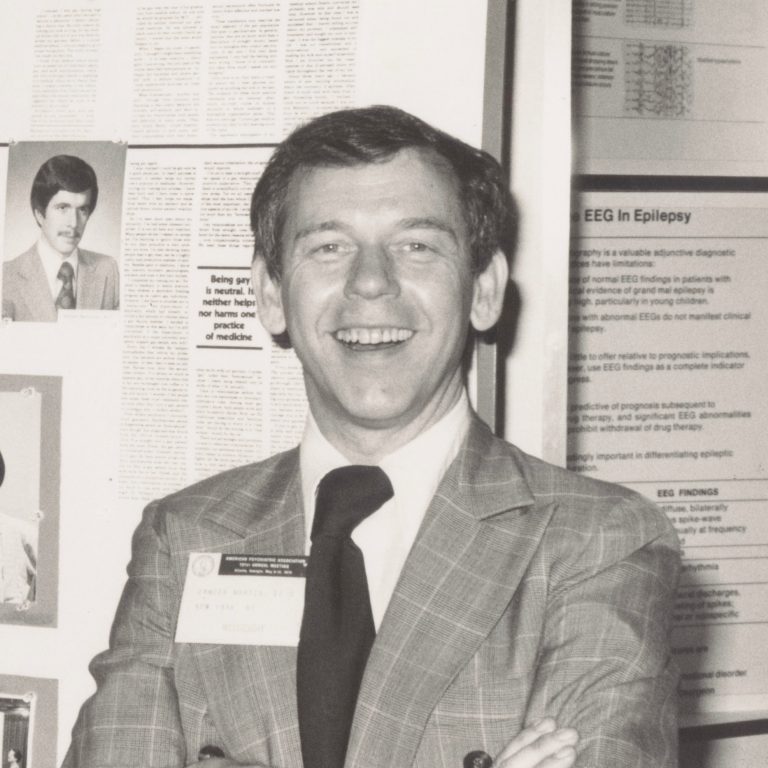 Damien Martin at the 1973 American Psychiatric Association Convention. Credit: Photo courtesy of National Gay and Lesbian Task Force records, #7301. Division of Rare and Manuscript Collections, Cornell University Library.
Damien Martin at the 1973 American Psychiatric Association Convention. Credit: Photo courtesy of National Gay and Lesbian Task Force records, #7301. Division of Rare and Manuscript Collections, Cornell University Library.Episode Notes
Damien Martin grew up in foster care and on the streets of Philadelphia, so he knew all too well about the needs of vulnerable youth. In 1979, when he and his partner, Dr. Emery Hetrick, heard about a 15-year-old gay kid thrown out of a shelter after being gang-raped, they decided to take action.
This Making Gay History episode has been made possible with support from Con Edison in honor of the 40th anniversary of the Hetrick-Martin Institute.
Episode first published December 19, 2019.
———
From Eric Marcus: There’s a special place in my heart for Damien Martin and his life partner, Emery Hetrick. I first met them in a 1984 photograph that accompanied a New York Times article under the then-shocking headline “Homosexual Couples Find a Quiet Pride.” There they were at home in their library looking like the Pete and Chasten Buttigieg of their day—subversively radical in their “normal-ness.” It was an image that contradicted every popular stereotype of gay men and male couples, and one that I found to be hopeful. The picture of domestic life that Damien and Emery presented was one I aspired to.
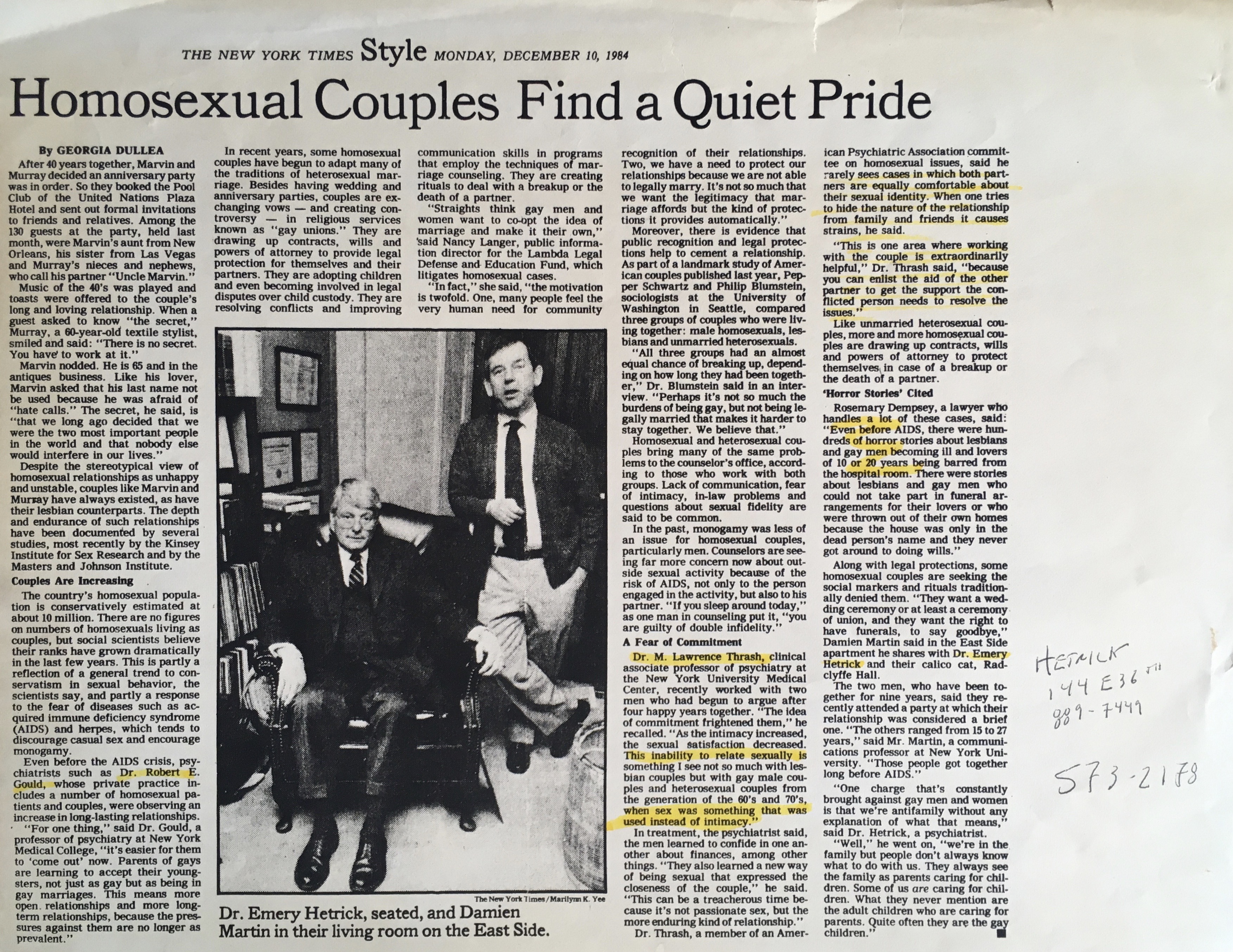
When I started research for my first book, The Male Couple’s Guide, Emery was the first person I interviewed. And Damien was one of the first people I interviewed for the Making Gay History book. I wanted to talk with him about the organization he and Emery founded in 1979—the Institute for the Protection of Lesbian and Gay Youth (now known as the Hetrick-Martin Institute or HMI). At a time when gay people were thought of as a threat to the safety of young people, Emery and Damien turned that destructive trope on its ear and founded an organization to provide support services to some of the most vulnerable among us.
By the time I interviewed Damien, Emery had already died of AIDS and I knew that Damien’s time was short. So I put Damien at the top of my list of people to interview sooner rather than later. It proved to be one of the most challenging interviews I’d ever conducted because of the questions I felt compelled to ask Damien about life after Emery and about facing his own death. We both cried.
To learn more about Damien Martin, please see the resources below.
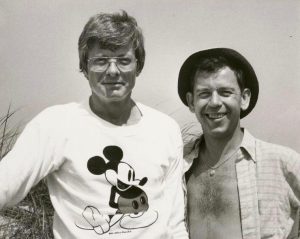
———
Learn more about Damien Martin in his 1991 New York Times obituary here. Damien’s oral history can be found in Eric Marcus’s book Making Gay History.
Read the 1987 obituary of Dr. Emery Hetrick, Damien’s partner in life and work, here. Damien and Emery are buried together in Brooklyn’s Green-Wood Cemetery; their gravestone reads, “Death ends a life, not a relationship.”
Eric first encountered Damien and Emery in the 1984 New York Times article “Homosexual Couples Find a Quiet Pride.” Read it here.
You can watch two interviews with Damien on the Gay Cable Network online. The first, which aired April 14, 1991, is part of a segment on LGBTQ youth and begins at about the 5:00 mark here. The second aired August 15, 1991, the same day Damien passed away from AIDS-related complications. It begins at the 48:11 mark here.
In the episode, Damien talks about his involvement with the New York chapter of Dignity, a Catholic LGBTQ organization. Dignity was founded in 1969; learn about its history here. The records of the organization’s New York chapter are kept at the LGBT Center Archives in New York City.
In 1979, Damien and Emery founded the Institute for the Protection of Lesbian and Gay Youth (IPLGY), later renamed the Hetrick-Martin Institute (HMI). Read more about the organization’s history here, and about the services they provide here.
IPLGY’s name offered a rebuttal to the so-called Save Our Children campaign of the late 1970s, which was led by Florida Citrus Commission spokesperson and one-time pop singer and beauty queen Anita Bryant. Learn more about Bryant and her hateful anti-LGBTQ campaign here and here. Boycotts and protests were organized by outraged LGBTQ groups across the country.
IPLGY opened its first office in 1983. In 1984, it established the Harvey Milk High School in partnership with the New York City Department of Education to provide LGBTQ youth with access to a public education in a safe environment.
Damien and Emery’s organizational efforts and research on LGBTQ youth provided a common language and citable resources to help professionals advocate for LGBTQ youth in schools. For some of Damien’s academic publications, see “The Perennial Canaanites: The Sin of Homosexuality”; “The Minority Question”; and a short excerpt of “Learning to Hide: The Socialization of the Gay Adolescent.”
Joyce Hunter (whom Damien mentions in the episode when he talks about the Latinx kid who was surprised to learn that there were old gay people) was one of IPLGY’s first employees and a co-founder of the Harvey Milk High School. Joyce was featured in her own Making Gay History episode here. In 1986, Damien and Joyce testified to Congress on behalf of LGBTQ youth; you can read their statement here.
The organization that Damien and Emery founded continues to grow. Learn about HMI New Jersey here.
Damien and Emery’s cat, Radclyffe Hall, was named after the author of the lesbian novel The Well of Loneliness. Hall’s papers are currently being digitized by the Harry Ransom Center at the University of Texas at Austin.
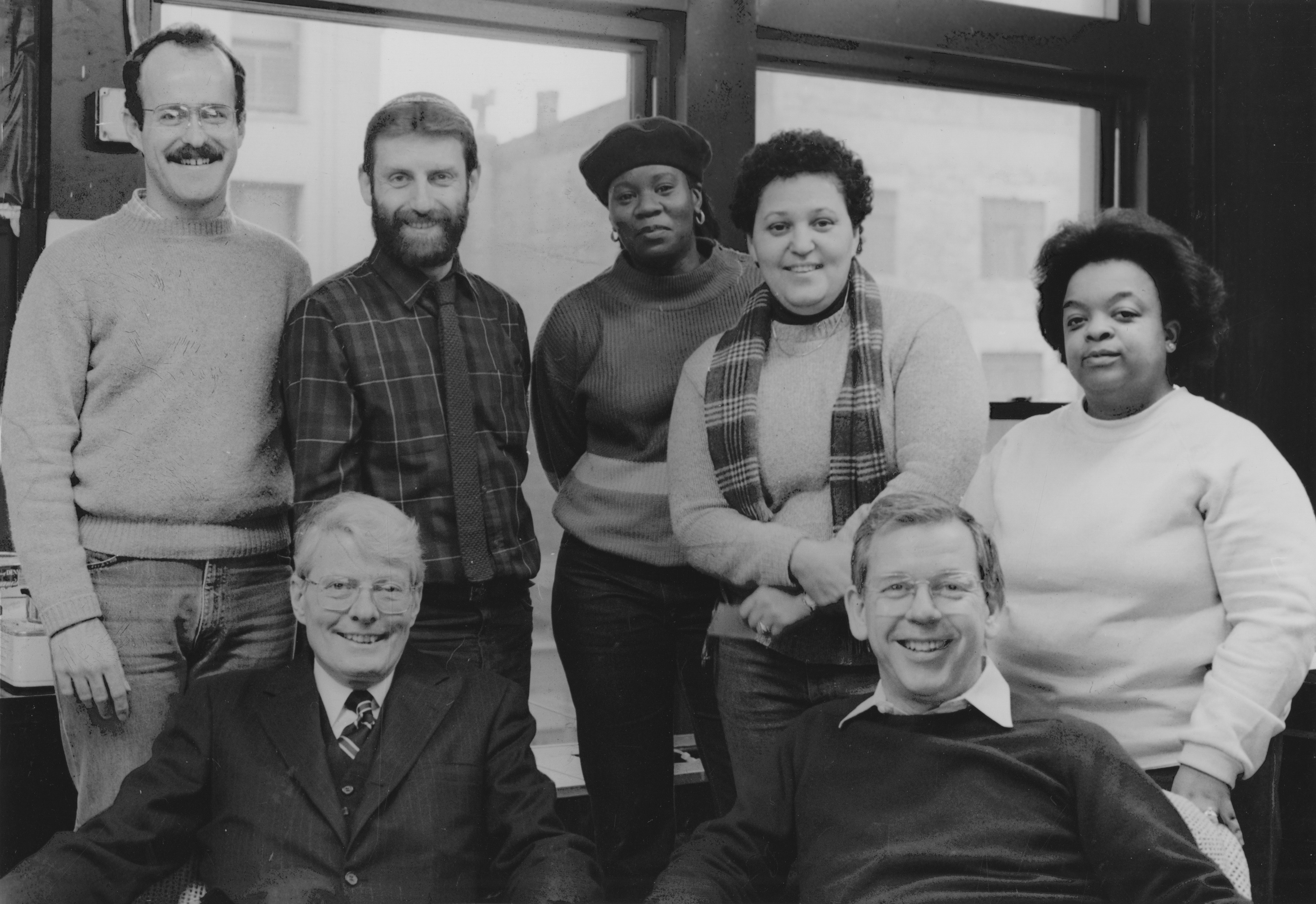
———
Episode Transcript
Eric Marcus Narration: I’m Eric Marcus and this is Making Gay History!
The first time I saw Damien Martin was on the New York Times “Style” page. It was December 10, 1984. The headline read “Homosexual Couples Find a Quiet Pride.” I’d never seen anything like it, and definitely not in the New York Times. Mainstream press coverage of LGBTQ people has changed so dramatically since then that it’s hard to explain just how shocking that headline was.
Almost as surprising was the photo that accompanied the article. Dr. Damien Martin and his partner Dr. Emery Hetrick. They looked so… average… A couple of conservatively dressed middle-aged men—a college professor and a psychiatrist—at home in their library. A domestic scene so out of step with depictions of gay men in 1984 that it looked bizarre to my 26-year-old eyes. Hopeful, too. I clipped the article and have saved it ever since.
Damien and Emery may have looked like a buttoned-down pair, but what they accomplished was nothing short of revolutionary. In 1979, recognizing the violence, homelessness, and isolation that so many LGBTQ kids faced, they founded the Institute for the Protection of Lesbian and Gay Youth. The odds against success were long. The Christian right had been actively painting homosexuals as recruiters and polluters of youth with a well-organized hate campaign called “Save Our Children.”
The toxic campaign fueled misconceptions and anxieties, and resulted in the repeal of recently passed gay rights legislation from Florida’s Miami-Dade County to Eugene, Oregon. Many people working in schools and youth social service agencies even believed—wrongly—that it was against the law to work with gay kids. Damien and Emery had their work cut out for them.
It’s the 40th anniversary of the founding of what’s now called the Hetrick-Martin Institute—or HMI. We bring you this special episode with the support of Con Edison in honor of HMI’s landmark anniversary and the organization’s co-founders, Drs. Emery Hetrick and Damien Martin.
So here’s the scene: it’s December 1988, and I meet Damien in his midtown Manhattan apartment, which he shares with Radclyffe Hall, an old calico cat. She’s named after the author of the seminal 1928 lesbian novel, The Well of Loneliness. Damien’s sitting on a sofa in front of a huge picture window, with the Chrysler Building in the near distance. He’s dressed casually, much as he was in the New York Times photograph—a Mr. Rogers minus the tie. But he looks exhausted.
His brown hair is flecked with silver and his complexion is an unhealthy gray. I have a very long list of questions for him and I already feel guilty for subjecting him to what I suspect is going to be a long interview.
However, I do know that Damien is eager to talk about the organization that he and Emery worked so hard to launch—to share its history while he still can. So I set up my equipment as we chat about little Miss Hall, clip the microphone to Damien’s shirt, and press record.
———
Eric Marcus: Interview with Damien Martin, Saturday, December 11, 1988. Interviewer is Eric Marcus. Location is the home of Damien Martin in New York City. Tape one, side one.
Damien Martin: When we first met, Emery had said to me, “Well, I don’t like cats.” And I said, “Well, that’s too bad because I’ll get rid of you before I get rid of her,” you know. And the moment she met him, that was it. She became his cat. And in the library here he saw his private patients. And she’d sit in his lap and she became known as the co-therapist. And he often said that there were some patients that she just obviously did not like and would not stay. And he began to trust her judgment. But, anyway, they became very close.

EM: I’d like to go back a bit in time. What year were you born?
DM: I was born in 1933. December 1933. I was born in Philadelphia. Very poor. Very, very poor. I have three older and three younger brothers and sisters. And when I was eight, the family broke up and I was placed in foster care. Catholic Children’s Bureau. Stayed in foster care ’til I was 18.
I knew I was gay from the time I was… I learned the word when I was about 10 or 11. I knew the word for it. Not gay—homosexual.
EM: Homosexual, right.
DM: I was visiting my mother, and my stepfather had hidden this book, quite appropriately, in the closet, and since it was hidden I knew I shouldn’t read it and I read it. And it was a book on sex perversions. And I… To use the terminology of today, my reaction was, ugh, how gross. It was sickening. Disgusting. Until I came to the section on homosexuality and I completely recognized myself in it.
I was a very devout Catholic, and… In fact, I wanted to be a priest. And, uh, the recognition of these feelings and the contradiction that that set up in my mind, the cognitive dissonance of, you know, “I can’t be a Catholic and do this or feel this” and so forth…
See, part of the thing was, I was very sexually active—I would commit the act, so to speak, have terrible, terrible guilt, go running to confession, swear never to do it again, but I would go running back five days later, you know. And this was the cycle that was going on. And that’s pretty wearing because you really do believe you’re not going to do it again.
When I was about 16, I finally stayed overnight with somebody. And I woke up in the morning. And it was a Sunday morning and I was going to go to mass. And I remember lying there thinking… We had been taught in school that if you pray long enough and hard enough you can get enough grace to resist any temptation.
And I was lying there, and I thought to myself, you know, I know I’ve been praying as hard as I can. But I’m not getting the grace to resist the temptation. So it must be for some reason God doesn’t want me to resist this. I’m doomed to hell, so why should I go through such agony if I’m going to go to hell anyway? And that broke the tie to the church. I stopped going to mass. Stopped going, you know… And I got involved in some very self-destructive behavior, including drinking and so forth and so on, which began to affect my schoolwork.
I was a street kid basically, but I was one of those street kids which you find that are able to maintain some sort of home base so that they can still stay in school and so forth. Because I did have enough sense to know that the one hope for a kid like me was to get a high school education and to get further education.
One of the things that I had learned during my adolescent [sic] was, again, you make contact through sex. That sexual hunt became really the basis for social interaction. You also had to lie to protect yourself. So I developed what so many men of my generation did—I had two lives. I had the lives that… The sexual life, which occurred in the bars and so forth, and then I had my other life with my friends, and the issue of sexuality never came up except I would tell the fag jokes and all just like everybody else and things.
And on a personal level, I was sort of saved by… I came to New York and I looked around for a group and I finally found this group that was made up of about 18 people, 16 women and two men. All the women were lesbians, and this group of lesbians was wonderful to me. I mean, they, um…
EM: Was it a formal social group or…?
DM: No, no. It was a drink—a group to stop drinking.
EM: Oh, okay, I’m sorry.
DM: Okay. And they… No, they all had drinking problems, too. And so that we were able first of all to meet on that level. But through these lesbians, many of whom are still friends of mine, I was able to start developing some interaction skills that were homosexually based, but not erotically based. For me, that was the important changing point.
EM: When did you meet Emery?
DM: Well, I met Emery at another one of these meetings I’m talking about. And, um, he actually had come to the meeting with an ex-lover of mine.
EM: What year was this?
DM: 1974. And, uh…
EM: So you had not gotten active in the movement still at that…?
DM: Mildly. What had happened was, around ’72, a, uh, again, this same ex-lover, the one that came with Emery to the meeting, said to me, “You ought to go up to Dignity.” And I said, “What’s Dignity?” and he told me. And I said, “Listen, the last thing in the world I need is a bunch of Irish Catholics sitting around beating their breasts and saying, ‘Why did God make me like this?’ You know. Forget it.” He kept nagging me about it. And so I thought, Well, what the hell, I’ll go up. Maybe there’ll be some cute Jesuits or something, you know. And there were.
But the thing was, I went up, and I’ll never forget, I went into this room, and they were having a business meeting. It was the first time, except for this other setting, where I was in a room with a bunch of gay men where sex was not the issue. It was something as simple as a business meeting and it was just overwhelming.
Dignity was very good for me. I mean, as I said, it was, I, for the first time, got involved in a movement activity and one in which people really were working together for a common goal and so forth…
One of my problems with Dignity was most of the people felt it was not a political organization and they should not indulge in political activities.
EM: But being gay is a pol— Being gay is a political… Someone said to me recently, he said, “Every time I wake up next to my lover in the morning, I realize I’m committing a political act.”
DM: Right. And it’s true. But there was one other very important thing that happened with Dignity for me. It was right around the time of the, I think it was the first gay rights bill, so it was ’72. They decided they couldn’t demonstrate in favor of the bill. But they decided what they could do was pray. So they went to, I think it was old St. Joseph’s, it’s right down near City Hall. It’s a Catholic church. I got very snotty and I said, “Well, I don’t believe in prayer and I’m not going to be able to this, that, and the other…” But what they did do… They needed something, I think it was a flyer saying, “Why we are here,” or something like that. So I agreed to pick it up and pull it—take it over.
So I got there and they’re standing on the church steps praying, rather than in the church. And I just stood across the street. And one of the guys came from the group, and he came over to me and he got the things. And I said, “What happened?” And he said, “Well, when the pastor found out what we were praying for, he threw us out of the church and he locked the doors. So we decided to have the prayer vigil here.” And he said, “Why don’t you come over.” And I said, “No, I can’t.” And I really was scared to death to go across. And that…
EM: Because?
DM: Pardon me?
EM: Because?
DM: Well, it was because I suddenly realized all my belief that I was out and I was handling my life and all was absolutely not true and I went home and I remember I got very depressed. And I didn’t realize how afraid I still was and how closeted I still was. So to get out of the depression, more than anything else, I said, “Alright, the next time I have an opportunity, anybody asks me to do anything, I’ll do it.”
EM: Why?
DM: I think it’s partially the Catholic background. I suddenly realized that, as much as I pooh-poohed these other guys, they were much braver than me, and that it was an act of cowardice on my part, and that in a way it was unjust for me to expect them to do the thing for me… It was partially the sin thing. It was almost like I was committing a sin by not coming out.
The first thing that came up after that was… There was an episode on Marcus Welby where they were going to have the child molestation…
———
EM Narration: Sorry to interrupt, but this needs a little explaining. Marcus Welby, M.D. was a long-running medical drama broadcast on the ABC television network. In 1973, activists had protested an episode that depicted homosexuality as an illness. A year later, hoping to avoid protests against another episode with a gay-related plot, the show’s producers shared a draft script with Ron Gold, the media director of the National Gay Task Force. The proposed episode featured a teenage boy who was sexually assaulted by his male science teacher. Gold objected to the all-too-familiar conflation of homosexuality and pedophilia, and advised ABC that the storyline was unacceptable. When ABC largely ignored his feedback, Gold mobilized the troops.
Back to Damien.
———
DM: Ron Gold called me up and asked me to spread the word to people that we should call at a certain time. So I called, and I remember…
EM: Called…?
DM: NBC or whatever it was, I think it was NBC. On a certain day. To literally tie up the phones for two days, which we did. It was a very effective thing. I called, and I remember they were very clever, they said, “All the lines are busy. Leave your name and number and we’ll call you back.”
And I remember getting this sharp pain in my stomach, and remembering this thing I’d said I was going to do it the next time… I said, alright, and I gave my name and address, and said, “And besides, here’s my office number.” And I worked at the V.A. at the time. And it really was a real fear that I could be fired for being a security risk and I thought, Fuck it. They did call me back. And I raised all kinds of hell on the phone and felt marvelous! Wonderful!
EM: Was it just time?
DM: Yes, and it was… But, see, I think it also depended on all the other things that had happened before. For a lot of us for that generation there had to be and there were a series of steps. It was not just a sudden revelation. It’s not so much you say, “I’m going to come out.” It’s the… really, the sort of, “I’m not going to put up with this anymore.”
Now with Emery, he had always been involved in social things and setting things up and had been quite radical. Although, the thing is, several people pointed out, he looked and was so establishment that he could say the most radical things and people would sit there and nod, you know, and think it was like the Daughters of the American Revolution putting out the thing. And he could get things through that way.
I mean, Emery was really the one who got the most involved organizationally with the movement. He got involved with… He started Gay Psychiatrists here in New York. He got very involved with the national psychiatric group. And then in 1979, that’s when we started the institute.
What happened was, Emery and I heard about a young man, 15 years old, who had been gang-raped and beaten up at one of the major youth shelters. But then he was the one who was thrown out because he was gay. Therefore it was his fault that he got gang-raped and beaten up. So I went into one of my typical Irish hysterical snits and got very angry, de-de-de-de-de… And Emery, who was a much calmer, more focused person in many ways, said, “Well, let’s see what we can do about this.”
So we got together a group of people. Emery asked a lot of psychiatrists and social workers and so forth and so on to come. Most of them agreed, yes, there was a real need. And, of course, as usual, two out of the 50 said, “Yes, let’s work together.”
EM: What was the date you opened your office?
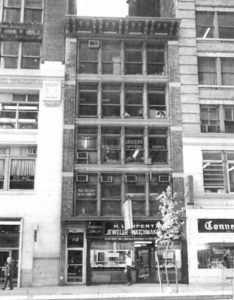
DM: It was in November 1983. It really took us four years. Four years to get that office opened. Now we had a problem. We couldn’t offer services or get a contract because we didn’t have an office. We couldn’t open an office because we didn’t have the money. And we needed the… So, in other words, it was that catch-22. Now, in the meantime, there had been this wealthy man in the community that we had gone to to see if we could get some money for a brochure.
And he said, “I’d like to come down to see you. I want to give you a donation.” It was Sunday night. And I didn’t want to, I wanted to go to the movies. But Emery said, no, “Come on down.” And I yelled, “Why don’t you put him off until tomorrow?” “No, no, no” he says, “it’s money, you grab it while you can,” and everything. So the guy came down, very casually dressed. He was wearing cowboy boots, and…
EM: Where was this you met him?
DM: Here. The apartment. He came to the apartment. We were talking. He said, “Well, you know, what would you do if you did have a chance to get started?” We told him our plans for an office. So he said, “How much do you think it would cost?” And we told him. And he said, “Well, I can’t do the whole thing.” And he says, “You know, here in New York you have to be so careful carrying money.” He said, “I always carry it in my boots.” And he reaches in and he takes out $25,000 in checks, and says, “That’s all I could squeeze into the boots. You’ll get another $25,000 tomorrow.”
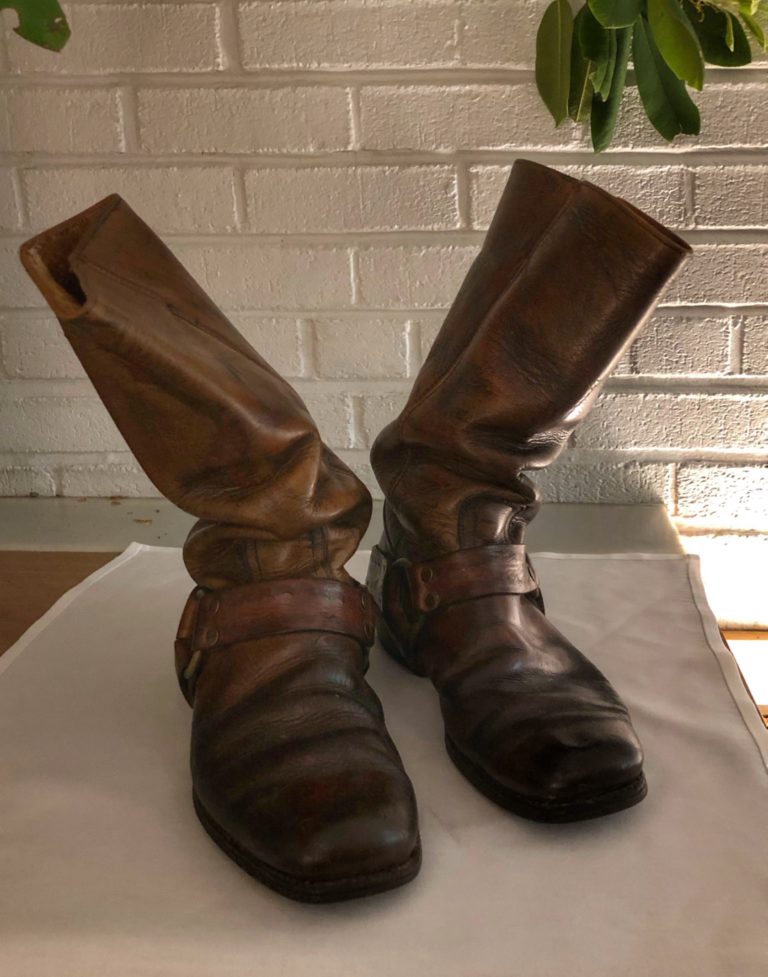
And I almost shit. That was it. We had the money to open the office. And I almost became a believer again. I mean, I haven’t had an urge to light candles like this since I was 12 years old.
EM: Do you remember the first kid who walked through the door?
DM: A lot of them get to you in many different ways. But I always remember this kid. I forget when he came in. I think it was, it was after we’d been in existence for at least a year. And I remember this young man, 14 years old. Hispanic family. And the father brought him down. The father had gone to court to try to get the kid placed someplace. Not because he wanted to, but the kid had been identified as gay in his neighborhood. He was constantly being beaten up. The father didn’t know what to do.
Joyce was doing the interview and then she sent the father off to get some coffee or something. And she was talking to the boy by himself. He was a little shy kid with his head down, a little tiny thing.
EM: How old was he?
DM: He was 14. And he suddenly said to Joyce, “Are you gay?” And she said, “Yes.” He said, “Is everybody here gay?” She said, “Well, not everybody, but most of us.” And I walked by and he said, “Is he gay?” She said, “Yes.” He said, “That old man?”
The reason I remember the kid was here was this frightened little kid, and this father who was heartbroken, but the circumstances of the world had led him to the point where this father was actually willing to give up his kid for his own safety. And for some reason that got to me that day and it’s been always one of the things I remember. There are a number of things like that that I remember.
I remember the case of the young girl, who by the way was not—so far as we know, she didn’t think of herself as a lesbian, or hadn’t identified as a lesbian yet… But she had developed a crush on her gym teacher and she sent the gym teacher a note. And I don’t know what her problem was, but she took the note to the principal, who called in the parents and said, “We can’t keep a child like this here. She could corrupt all the others. If there’s no place to put her, put her in a school for the learning disabled.” That’s how we got her because one of the counselors there knew about us and brought her over.
And this kid just didn’t know what had happened. She had no idea what she’d done wrong, what was happening. The parents were ashamed. It was one of the times when I could understand violent revolutionaries. I mean, I really wanted to go out and just punch that guy right in the mouth. I didn’t, but I wanted to. There are a lot of kids like that and stories like that.
One of the main things I remember about being a kid caught up in the institutions—and that includes school, and so forth and so on—that if you are a kid, it doesn’t matter whether you’re right or wrong. I mean, it’s the adults who control the situation. So very often the greatest need is for another adult to come in and say, “What in the hell is going on here?” And that’s really one of the greatest needs the kids have.
It’s not that I particularly like kids. I mean, it’s one of the reasons I’m glad I’m on the administrative end of it, because they get on my nerves, you know. I probably never would have been a good father, you know. I don’t like the noise. I find them silly, and so forth. But they have a right to be noisy. They have a right to be silly. They have a right to be teenagers. And that’s one of the things that I think our kids are denied. They’re denied the right to be teenagers. And they should have that right. And be pains in the asses, you know, without being beaten up or thrown out on the street or anything else for it.
EM: So what you do at the institute then is you give them the right to be teenagers.
DM: Yes. Hm-hm.
I think that the institute is probably one of the most, if not the most, radical thing that the movement has done. Because we took what was the most effective political charge against us, the biggest hate campaign, that we’re a danger to children and to families, and we’ve, as you said, turned it around. I mean, what we said was, “No, that’s not true. What you people are doing is a danger to children and to our children in particular.” But we often make the point that it’s a danger to straight kids, too. You don’t teach straight kids to hate without damaging them.
EM: When did you become aware that AIDS was going to be a big issue, not only personally, but in the, for your work with the institute.
DM: We really began to think of it as an issue for adolescents, I think probably in 1984, after we’d opened up. All the various factors about the disease and the, the information we were getting and all, we just thought at the institute, you know, these kids have to be at risk.
EM: When did AIDS become an issue in your life with Emery?
DM: We went to… In ’84 we went to Italy and everything was fine. And we came back. And Emery started having night sweats. He started panicking. And I just said, “It’s your imagination.” And I really got irritated with him and I was not at all supportive. There was a great deal of denial going on there.
And this went on for about five months, into January of ’85. And he did develop a fever and he was having trouble breathing and coughing. So we went to a physician who said to him, “I think it’s pneumocystis. I’m going to have you examined right away.” And he called me, I’ll never forget, I was going out to a training, and I had all along been saying, “Nothing’s wrong. Nothing’s wrong. Nothing’s wrong.” And Emery got on the phone and he was crying. And he said, “Can you come right away?” And I knew what it was right away. And so I dashed out, took a cab home, and the two of us sort of sat here and cried for four hours.
The next day they did a bronchoscopy as an outpatient. And I went up with him and everything. And they didn’t find any, they didn’t find any pneumocystis. Which in one way was fortunate and in another way was unfortunate because it fed into my denial. I said, “Well that’s it. You’ve got something wrong with you. It’s not AIDS. That’s all there is to it.”
Emery was so important to me that I just couldn’t allow that thought to enter my mind at that point. So that proceeded into… For the next year, Emery was ill, he had tremendous fevers, difficulty breathing. They kept checking him for pneumocystis and it wasn’t there. And we were going crazy not knowing what it was.
Finally, they just said, “We don’t know what’s happening. We have no idea what’s happening. We want to do open lung surgery.” And so they did. And I still remember, poor baby, his respiration was so bad by that time that they had to be very careful with the anesthesia. And he came out of it while they were sewing him up.
I was waiting in the room. And I could hear him screaming. And I went flying down the hall, ready to hit somebody. And they were struggling to keep him from pulling things out because he was… And I remember, I sort of… I literally got on the stretcher with him to hold him down, and he looked at me and he said—he calmed down for a second and he said—“I don’t like it here. I want you and Radclyffe to take care of me, take me home.”
But the thing was, as a result of the surgery, um… They came in and they said, “We still don’t know what’s going on. All we know is your lungs are turning to Styrofoam and we don’t know why.” By this time Emery and the doctors, though, were positive it was AIDS-related.
EM: And you?
DM: I was, but I wouldn’t say the word. I just refused to say the word. But by this time the word didn’t matter. He had it.
EM: And you lost him when?
DM: It was February of 1987. It was, it’ll be two years this coming February.
EM: Right. How have you been able to carry on?
DM: Well, there are two things. And I think, um… I haven’t talked much about this with people so I…
Three months before Emery died I was diagnosed with AIDS. And, poor baby, I remember he was upset on a number of levels, but the major one was, “Who’s gonna take care of you, you know, like you’ve taken care of me?”
And I think the main reason I was able to handle it was because I really thought I was going to die very soon, so it didn’t matter that much. So what I did was I just got even more involved in the institute with the idea of getting things ready for when I was gonna leave to, uh, you know, just… That there would be an organization that would be strong enough that could survive the loss of the two of us and that would go on.
EM: Also would have been your legacy.
DM: Yes. And Emery’s. Plus I also felt as though I was working with Emery. And so in a way there it helped me with my grief. In the sense that it was not like I’d lost everything. We still were working together.
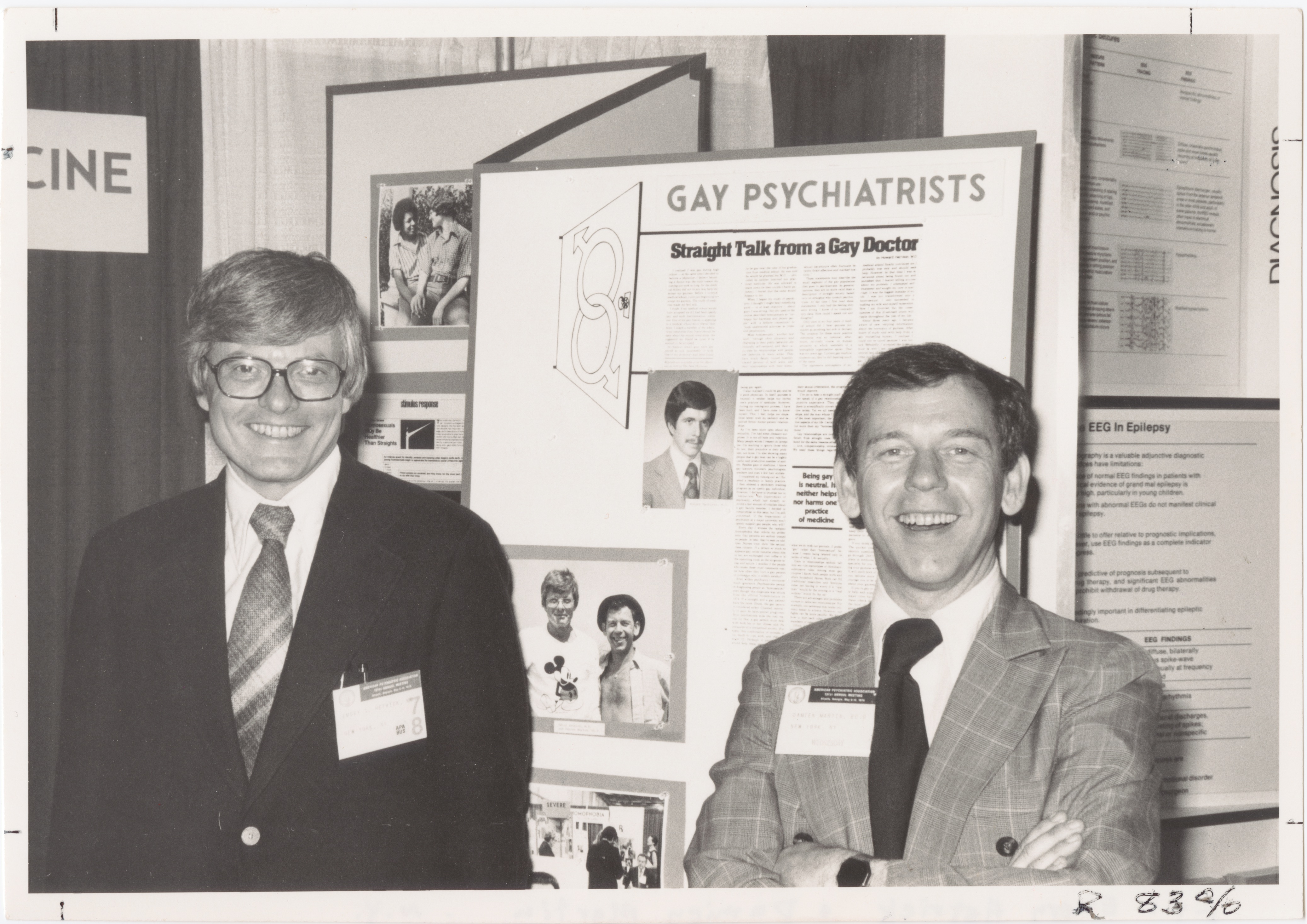
I mean, without Emery there really isn’t a life. You know, I mean, it’s a…
Emery was the first person in my life that I was able to trust completely, completely. No reservations. And it’s very difficult not to have that. It’s just the, the world seems like not a very important place without him here. Things are so radically changed.
We really became a unit. And that unit no longer exists so I feel very incomplete all the time. It’s not just lonely, although I’m very, very lonely. But it’s just very incomplete. And that’s hard to take when you’ve felt complete and so forth, it’s a… In fact, people have said to me, “Well, you must have been relieved when his sufferings ended.” And I wasn’t. I mean, toward the end, he was very sick and I really had to take care of him. And I feel privileged that I was there to do it. And it was another level of our unity, if you will.
EM: You still had him.
DM: And there is nothing so bad… All the worst times during his illness were not so bad as not having him.
I’m not afraid of death. And I’ve already made arrangements to have somebody take care of little Ms. Hall. She has an uncle Arthur who comes over to feed her when I’m away so he’ll take care of her. I usually just don’t think about death anymore. But every once in a while it’ll come. It’ll come in various ways. I’ll, uh, you’re buying a suit and I’ll think, What the hell are you buying a suit for? You’ll probably be dead in six months. And I’ll think, Well, so you’ll be a well-dressed corpse, and I’ll buy the suit.
EM: So the end doesn’t frighten you.
DM: No.
EM: Cause you’ve already started…
DM: Right.
EM: Yeah.

———
EM Narration: Damien Martin died from complications of AIDS on August 15, 1991. He was 57.
Today, the Hetrick-Martin Institute is the nation’s largest LGBTQ youth services organization. It offers care and counseling to over 2,000 young people each year and provides programs to safeguard their mental, emotional, and physical health. HMI is also home to the Harvey Milk High School, a fully accredited New York City high school that offers at-risk youth access to a public education in a safe environment.
Advocacy remains a big part of the institute’s mission—and HMI trains elected leaders, educators, and service providers from across the world to carry that advocacy into their own communities.
On this 40th anniversary of HMI’s founding, Making Gay History honors the memory of Damien Martin and Emery Hetrick, and congratulates those who have carried on and expanded their visionary mission to look out for the best interests of vulnerable LGBTQ youth.
———
Many thanks to everyone who makes Making Gay History possible: senior producer Nahanni Rous, producers Josh Gwynn, Janelle Anderson, and Andre Bellido, deputy director Inge De Taeye, audio engineer Jeff Towne, researcher Brian Ferree, photo editor Michael Green, and our social media team, Cristiana Peña, Nick Porter, and Denio Lourenco. Special thanks to Jenna Weiss-Berman and our founding editor and producer, Sara Burningham. Our theme music was composed by Fritz Myers.
Making Gay History is a co-production of Pineapple Street Studios, with assistance from the New York Public Library’s Manuscripts and Archives Division and the ONE Archives at the USC Libraries.
Season six of this podcast has been made possible with funding from the Jonathan Logan Family Foundation, the Calamus Foundation, Broadway Cares/Equity Fights AIDS, the Small Change Foundation, Irwin and Andra Press, and our listeners, including K.J. Rawson. Thanks, K.J.!
A very special thank-you to Con Edison for underwriting this episode in honor of the Hetrick-Martin Institute’s 40th anniversary. The Hetrick-Martin Institute believes that all young people, regardless of sexual orientation or identity, deserve a safe and supportive environment in which to achieve their full potential. For more information about HMI and the services they provide, please visit hmi.org.
To keep track of what we’ve got planned for our next season, sign up for our newsletter at makinggayhistory.com. And if you’ve only recently discovered us, there are more than 60 episodes just waiting to be heard.
On behalf of the entire Making Gay History crew, I wish you all good things over the holidays and in the new year ahead.
So long! Until next time!
###